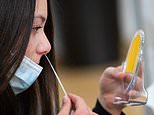WHAT IS THE DIFFERENCE BETWEEN A PCR TEST AND A LATERAL FLOW?
A PCR test can cost upwards of £180 per person, with the swab needing to be processed in a lab.
The UK, on the other hand, favours faster tests which are not lab based and give a result within 15 minutes.
These rapid coronavirus tests, known as lateral flow tests, are ones that can be done on the spot using portable equipment.
They are faster and cheaper than lab-based PCR tests, which the government uses to diagnose people, but are less accurate.
LATERAL FLOW TESTS ARE RAPID – BUT CAN SACRIFICE ACCURACY
In a lateral flow test a swab is used to get a sample from the person’s nose or throat and it is then processed in a small machine that tries to detect the coronavirus by mixing the sample with something the virus would react with.
If there is a reaction in the mixture it suggests that the person is carrying coronavirus. If not, they get a negative result. This process can be completed in as little as 15 minutes.
You take your own swab though a professional on site processes it through the machine.
Lateral flow miss up to half of cases, by the Department of Health’s own admission.
But damning evidence shows they may be effectively useless when self-administered, despite Downing Street’s current testing scheme relying on people taking their own swabs.
The tests are more accurate when swabs are carried out by trained professionals because they have to be pushed deep inside the nose.
But scientists fear Britain simply doesn’t have the money or enough spare medics to do this nationwide every day, with health chiefs instead accepting DIY swabs to save time.
PCR TESTS CAN TAKE SEVERAL DAYS TO GET RESULTS – BUT ARE MORE ACCURATE
These lateral flow tests differ from the gold standard PCR test – known scientifically as polymerase chain reaction testing.
PCR tests also use a swab but this is then processed using high-tech laboratory equipment to analyse the genetic sequence of the sample to see if any of it matches the genes of coronavirus.
This is a much more long-winded and expensive process, involving multiple types of trained staff, and the analysis process can take hours, with the whole process from swab to someone receiving their result taking days.
It is significantly more accurate, however. In ideal conditions the tests are almost 100 per cent accurate at spotting the virus, although this may be more like 70 per cent in the real world.
This compares to a much lower sensitivity in lateral flow tests, with a trial of one type used in Liverpool suggesting they miss around 50 per cent of the people who would test positive with PCR.
SO, WHAT IS THE BENEFIT OF LATERAL FLOW TESTING?
Extreme accuracy may be a drawback for PCR now that so many people have been infected, however, with the tests able to detect shreds of the virus in people who recovered weeks ago and are no longer infectious, which may lead them to have to self-isolate unnecessarily.
Lateral flow tests are more likely to miss people who are carrying the virus but, experts say, do have value as a way of weeding out people carrying large amounts of the virus and therefore most likely to be spreading the disease.
